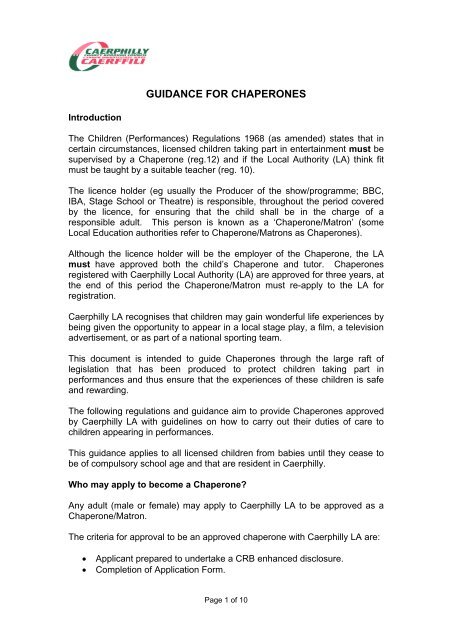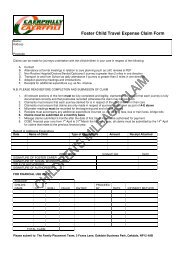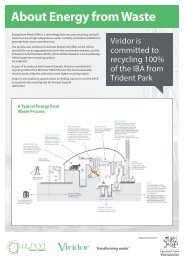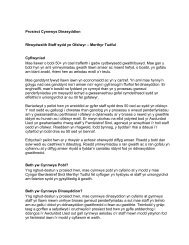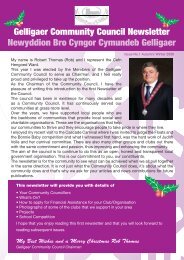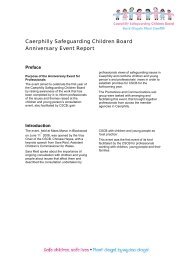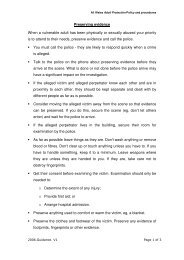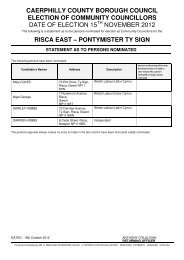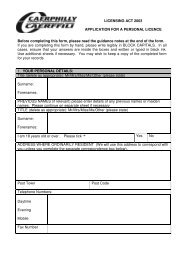Chaperone information leaflet
Chaperone information leaflet
Chaperone information leaflet
You also want an ePaper? Increase the reach of your titles
YUMPU automatically turns print PDFs into web optimized ePapers that Google loves.
GUIDANCE FOR CHAPERONESIntroductionThe Children (Performances) Regulations 1968 (as amended) states that incertain circumstances, licensed children taking part in entertainment must besupervised by a <strong>Chaperone</strong> (reg.12) and if the Local Authority (LA) think fitmust be taught by a suitable teacher (reg. 10).The licence holder (eg usually the Producer of the show/programme; BBC,IBA, Stage School or Theatre) is responsible, throughout the period coveredby the licence, for ensuring that the child shall be in the charge of aresponsible adult. This person is known as a ‘<strong>Chaperone</strong>/Matron’ (someLocal Education authorities refer to <strong>Chaperone</strong>/Matrons as <strong>Chaperone</strong>s).Although the licence holder will be the employer of the <strong>Chaperone</strong>, the LAmust have approved both the child’s <strong>Chaperone</strong> and tutor. <strong>Chaperone</strong>sregistered with Caerphilly Local Authority (LA) are approved for three years, atthe end of this period the <strong>Chaperone</strong>/Matron must re-apply to the LA forregistration.Caerphilly LA recognises that children may gain wonderful life experiences bybeing given the opportunity to appear in a local stage play, a film, a televisionadvertisement, or as part of a national sporting team.This document is intended to guide <strong>Chaperone</strong>s through the large raft oflegislation that has been produced to protect children taking part inperformances and thus ensure that the experiences of these children is safeand rewarding.The following regulations and guidance aim to provide <strong>Chaperone</strong>s approvedby Caerphilly LA with guidelines on how to carry out their duties of care tochildren appearing in performances.This guidance applies to all licensed children from babies until they cease tobe of compulsory school age and that are resident in Caerphilly.Who may apply to become a <strong>Chaperone</strong>?Any adult (male or female) may apply to Caerphilly LA to be approved as a<strong>Chaperone</strong>/Matron.The criteria for approval to be an approved chaperone with Caerphilly LA are:• Applicant prepared to undertake a CRB enhanced disclosure.• Completion of Application Form.Page 1 of 10
• Submission of two references.• An awareness of relevant legislation.• Have undertaken safeguarding/child protection awareness trainingThe LA shall not approve a <strong>Chaperone</strong> unless satisfied that they can exerciseproper care and control of the child (ren) and they will not be prevented fromcarrying out their duties as a <strong>Chaperone</strong> by other duties.Applications for the post of <strong>Chaperone</strong> are to be addressed to:Education Welfare ServiceCaerphilly County Borough CouncilTy PenalltaTredomen ParkYstrad MynachHengoedCF82 7PGTelephone: 01443 866687Email: educws@caerphilly.gov.ukOther Registration Requirements of Caerphilly LA (note: these requirementsare not statutory, but are expectations of Caerphilly LA)When approved, <strong>Chaperone</strong>s are required to notify Caerphilly LA (the ChildEmployment Officer) in writing within seven days of:• Any arrest for an offence that can be tried in a Court of Law• Any conviction following an arrest, whether in the UK or otherwise• Any serious or notifiable illness or disease• Any change of address or name.The <strong>Chaperone</strong> should ensure that they carry their certificate on every daythat they are employed as a <strong>Chaperone</strong> and have it available for inspection.The <strong>Chaperone</strong> should have a basic understanding of emergency first aidtreatment and also establish that the licence holder has made appropriateprovision under the Health and Safety (First Aid) Regulations. The<strong>Chaperone</strong> should acquaint themselves with the names of the appointed firstaiders and the whereabouts of the first aiders and the whereabouts of the firstaid equipment in the establishment/premises in which they are working.The <strong>Chaperone</strong> should have a basic understanding of the ‘duty of care’ in aworkplace situation and be satisfied that suitable risk assessments have beencarried out by those responsible for the rehearsal/performance. The<strong>Chaperone</strong> should be satisfied that any risks that may affect the child (ren) intheir care have been identified and effective control measures are in place.Page 2 of 10
Duties and Responsibilities1. The post of <strong>Chaperone</strong> is one of responsibility and trust. The primeduty of the <strong>Chaperone</strong> is to the child (ren) in their care.2. The <strong>Chaperone</strong> should make themselves thoroughly familiar withthe terms of the performance licence granted by the LA and seethat as far as lies within their power the conditions are properlyfulfilled.3. The licence holder is responsible for ensuring that, during theperformance and all activities related to a performance (such as arehearsal), the child is in the charge of a person who has beenapproved by the LA for this purpose: the <strong>Chaperone</strong>. The onlyexception to this rule is when the child is in the charge of theirparent/carer or a tutor.4. <strong>Chaperone</strong> acting under licensing regulations shall be considered tohave the care and control of the child (ren) with a view to securingtheir health, comfort, kind treatment and moral welfare.5. The <strong>Chaperone</strong> should ensure that there is a complete register ofthe children, with emergency contact numbers, available at alltimes. However, the <strong>Chaperone</strong> must not disclose the personal<strong>information</strong> of the child (ren) in their care except to authorisedpersonnel.6. The <strong>Chaperone</strong> must be aware of the Area Safeguarding BoardProcedures. These should be available from the licence holder ifnot a copy can be obtained from the LA.7. Corporal punishment must not be used in any circumstances.8. A private teacher may act as a <strong>Chaperone</strong>, if approved as such bythe LA, provided the number of children in their care does notexceed three, and that the LA are satisfied that the arrangementswill not adversely affect the child (ren’s) education or welfare.9. The <strong>Chaperone</strong>s first duty is to the child (ren) in their care. Whilstthey are acting as a <strong>Chaperone</strong> they may not engage in any otheractivity that would interfere with the performance of their duties.10. Except when a child is in the care of a teacher, the <strong>Chaperone</strong> is inloco parentis and should exercise a duty of care, which anyparent/carer might be reasonably expected to give that child.11. The <strong>Chaperone</strong> shall be in charge of the child (ren) at all times,except when in the charge of their parent/care/tutor.12. The maximum number of children a <strong>Chaperone</strong>/Matron may have intheir care is 12.13. <strong>Chaperone</strong>s should be gender appropriate. The <strong>Chaperone</strong> mustbe with the child (ren) under their supervision at all times (exceptwhen actually performing or in the care of a parent/carer or tutor).14. The <strong>Chaperone</strong> must be satisfied with the arrangements for thedressing room (children 5 years old and above must only changewith other children of the same sex), toilet facilities etc.15. To ensure that, when a child is not actually performing they haveadequate meals, rest and recreation.16. The child must leave the theatre after each performance, not laterthan 30 minutes after the end of their part, or10:00 pm (for childrenPage 3 of 10
under 13 years), 10:30 pm (for children 13 years and over)whichever is the earliest (see page 10 for permitted hours).17. The <strong>Chaperone</strong> is required to ensure that suitable travelarrangements are in place for each child in their care; also toensure that the child is collected by the person agreed by priorarrangement.18. The <strong>Chaperone</strong> must inform the Child Employment Officer of anyconcerns.19. The <strong>Chaperone</strong> should be aware of the procedure for theevacuation of the building in case of fire.20. In the event of any contravention of the licence, or incident affectingthe well-being of the child (ren) the <strong>Chaperone</strong> must inform thelicensing LA at the earliest opportunity.21. Caerphilly LA expects that <strong>Chaperone</strong>s authorised by them willensure that no child is discriminated against on the grounds of race,gender, colour nationality, ethnicity or national origin.22. If dressers/helpers are required, then at no time should they be leftalone with a child. An approved <strong>Chaperone</strong> must always bepresent. The dressers/helpers should not take children to thebathroom alone. The dressers/helpers should speak to a<strong>Chaperone</strong> if they have any problems/concerns.Illness or Injury of ChildIf a child suffers any injury or illness whilst in the charge of a <strong>Chaperone</strong> ortutor, the holder of the performance licence shall ensure that, if necessary, adoctor is called and that the parent/carer of the child named in the applicationform are notified immediately of such injury or illness.The <strong>Chaperone</strong> must keep a record of any such instances of illness or injuryand any action taken.Should the child fall ill whilst on tour and is too ill to perform, the <strong>Chaperone</strong>should make arrangements for the child to be sent home under proper escort.In the case of serious illness/accident the child should be sent to hospital andthe child’s parent/carer informed immediately. The LA that issued the licenceshould also be informed as soon as is possible, the <strong>Chaperone</strong> must recordthe incident and action taken.No child may perform if unwell.Specific HazardsBelow is a list of known hazards associated with theatrical and filmperformances. The list is not exhaustive but covers some of the morecommon areas that may give cause for concern.• Fire Procedures (eg Alarm Bell, Fire Drill etc)• Safe place to stand in wings or off the set• Movement of sceneryPage 4 of 10
• Flying scenery• Movement of any machinery• Periods of temporary darkness (eg scene change)• Falls from a height• Smoke effects and dry ice• Noise• Pyrotechnics• Trapdoors• Animals• Electrical cables• Very bright lightingIf the performance is outdoors then in addition to the above the followingshould also be considered:• Protection from inclement weather• Movement of vehicles• Rivers, cliffs and other natural features that pose potential risksSpecific Performing ActivitiesFilming and Other Broadcast RecordingA child appearing in a film may be at the studios or place of location for muchof the day. During the whole of this time they are in the <strong>Chaperone</strong>’s charge,except when having lessons (in the care of the tutor) or on set (when thedirector is responsible). The <strong>Chaperone</strong> will accompany the child from thedressing room or schoolroom, and remain on the set with the child (ren).The <strong>Chaperone</strong> should keep records of the times the child is on the set andthe times they rehearse and perform, so as to ensure that the periodspermitted under the Regulations are not exceeded. The <strong>Chaperone</strong> shouldalso ensure that the child does not get less than the required number ofbreaks for rest and meals (see page 12).The <strong>Chaperone</strong> should ensure that any child in their supervision has suitableopportunities for recreation and that the child is protected from stress, strain,bad weather and any other conditions likely to cause harm.The <strong>Chaperone</strong> may allow the child to perform for a further thirty minutesbeyond the latest permitted hour as long as the total number of hours(including the extra 30 minutes) does not exceed the maximum number ofpermitted hours. This discretionary thirty-minute period may be used if the<strong>Chaperone</strong> is satisfied that the welfare of the child will not suffer and thereasons for the extra 30 minutes are outside the control of the licence holder.The <strong>Chaperone</strong> must inform the LA of any such occurrence as soon aspossible, no later than 4:30 pm the following working day.The <strong>Chaperone</strong> may allow one daily interval, put aside for a meal break, to bereduced when the child is working outdoors, provided that the reduced breakPage 5 of 10
is not less than half an hour. Even with the reduction, the total number ofhours worked by the child must not exceed the permitted maximum.Theatre, Paid Sport and ModellingIf the child is working in a theatre or place of rehearsal, the times of when theyare present must comply within what is permitted in the Regulations.The <strong>Chaperone</strong> must ensure that, when the child is not actually performing,they are properly supervised and have adequate meals, rest and recreation.This includes any period between performances if there are two performanceson the same day and the child does not go home or to their lodgings.Children on TourIf the child is living away from home, the <strong>Chaperone</strong> is responsible for themthroughout the period of the licence and ensuring they are properly occupiedin their spare time. In general, a <strong>Chaperone</strong> needs to exercise a greateramount of supervision than if the child were living at home during the period ofthe licence. The duty of the <strong>Chaperone</strong> with regards to lodgings is to securethe child’s health, comfort, kind treatment and moral welfare.Although the legislation states the maximum number of children a <strong>Chaperone</strong>should have in their care is 12, Caerphilly LA recommends that the maximumnumber of children supervised during a tour should be five per <strong>Chaperone</strong>.The <strong>Chaperone</strong> should ensure that there are suitable arrangements for meals.Food should normally be provided at the lodgings. The children must be inthe constant charge of the <strong>Chaperone</strong>, who must accompany them at alltimes.The <strong>Chaperone</strong> should arrange to lodge in the same place of accommodationas the child (ren), preferably in a room near to that occupied by the child (ren).The lodgings have to be approved by the LA in whose area they are situated,but if for any reason the <strong>Chaperone</strong> considers them to be unsatisfactory the<strong>Chaperone</strong> should insist on a change of accommodation.The <strong>Chaperone</strong> should ensure that the child (ren) have adequate exercise.Child ProtectionEverybody who works with children, or works with parents and other adults incontact with children should be able to recognise, and know how to act upon,indicators that a child’s welfare or safety may be at risk.The abuse or harm to children may occur from:• Parents;• Others who have parental responsibility;Page 6 of 10
• Adults who are in a position of trust or who are temporarily entrustedwith their care;• People who, through not having parental responsibility, are knownwithin a wider circle of the family or neighbourhood;• A complete stranger• Other children.It is vital for anyone working with children to consider the indicators of abuse,based on knowledge and observation of the child. The status of the person atthe cause of the suspicion should in no way prejudice your responses to thesituation. Research clearly demonstrates that professionals do abusechildren, their professional standing and accreditation is not a guarantee oftheir intent. The All Wales Child Protection Procedures clearly lists theexpected actions if a professional is causing a concern for children.The following definitions of abuse are given to assist professional staff andthose providing services to children in assessing whether abuse may haveoccurred.NeglectThe persistent failure to meet a child’s basic physical and/or psychologicalneeds, likely to result in the serious impairment of the child’s health ordevelopment. It may involve a parent or carer failing to provide adequatefood, shelter and clothing, failing to protect a child from physical harm ordanger, or the failure to ensure access to appropriate medical care ortreatment. It may also include neglect of, or unresponsiveness to, a child’sbasic emotional needs. Non-organic failure to thrive may be a feature or aresult of neglect.Physical AbusePhysical abuse may involve hitting, shaking, throwing, poisoning, burning orscalding, drowning, suffocating, or otherwise causing harm to a child.Physical harm may also be caused when a parent or carer feigns thesymptoms of, or deliberately causes ill health to a child whom they are lookingafter. This is commonly described as “Munchausen syndrome by proxy”. Anyinstances of female circumcision or infibulations will be regarded as physicalabuse under the Prohibition of Female Circumcision Act 1995.Sexual AbuseSexual abuse involves forcing or enticing a child or young person to take partin sexual activities, whether or nor the child is aware of what is happening.The activities may involve physical contact, including penetrative (eg rape orbuggery) or non-penetrative acts. They may include non-contact activitiessuch as involving children in looking at, or in the production of, pornographicmaterial or watching sexual activities, or encouraging children to behave insexually inappropriate ways of failing to discourage them from suchbehaviour.Page 7 of 10
Emotional abuseEmotional abuse is the persistent emotional ill treatment of a child such as tocause severe and persistent adverse effects on the child’s emotionaldevelopment. It may involve conveying to children that they are worthless orunloved or inadequate. It may cause children to feel frightened or in danger,or the exploitation or corruption of children. Some level of emotional abuse isinvolved in all types of ill treatment of a child, though it may occur alone.Abuse of TrustA relationship of trust, for the purpose of this guidance, is one where ateacher, member of education staff or a volunteer is in a position of power toinfluence over a child by virtue of the work or nature of the activity beingundertaken. A relationship of trust must not be distorted by fear or favour andthose in positions of trust must exercise responsibility as a consequence ofthe power they have over those they care for. Where a relationship of trustexists, allowing a relationship to develop in a way that might lead to a sexualrelationship is wrong. A sexual relationship will be intrinsically unequal withina relationship of trust and is therefore unacceptable. It is also inappropriatesince the professional relationship of trust would be altered. This guidanceshould not be interpreted to mean that no genuine relationship can startbetween two people within a relationship of trust, but given the inequality atthe heart of a relationship of trust should be ended before any sexualrelationship develops.What to do if suspected/alleged child abuseThe All Wales Child Protection Procedures (AWCPP) clearly guides allprofessionals through the expectations of agencies in matters of childprotection. All professionals working with children should be familiar with thisguidance, and the responsibilities it places upon them. A copy of the AWCPPguidance can be found in the ‘Useful Documents’ section of the CaerphillySafeguarding Children Board website. Practitioners can also find useful links,contacts and guidance related to the Safeguarding of children on this websiteThe AWCPP is the stand-alone guidance for all professionals working withchildren in Wales. Even in instances where your work takes you outside ofWales these procedures should be followed if the child’s usual residence is inWales. If there is an incident of abuse whilst a child is in your charge, thelocal police to your location at that time should be informed immediately. ThePolice will assist you in ensuring the relevant Social Services referrals aremade.Below is a link to Caerphilly Safeguarding Children Board, where you will finduseful documents including the All Wales Child Protection Procedureshttp://www.caerphilly.gov.uk/cscbPage 8 of 10
The following procedures must be carried out in every case of actualsuspected or alleged child abuse that comes to the attention of the<strong>Chaperone</strong>.Medical Emergency with Suspicion of AbuseA child requiring urgent medical attention should be escorted to the nearestAccident and Emergency Department. Where possible, a parent or carershould accompany the child, if a parent or carer unreasonably refuses to allowthe necessary medical treatment, the Police should be contacted immediately.The escort must remain with the child until such time as the child’s safety isassured. The <strong>Chaperone</strong> should ensure that Social Services and theEducation Child Protection Officer are informed immediately.Suspicion of Abuse without Medical EmergencyIf a <strong>Chaperone</strong> has knowledge or suspicion of abuse from any source theyshould refer to Social Services without delay who will decide whether toinvestigate further. If so, arrangements for parental contact will be agreed. Inall but the most exceptional circumstances Social Services will make parentalcontact.Disclosure of AbuseIf a child tells a <strong>Chaperone</strong> that they have been, or is likely to be abused, the<strong>Chaperone</strong>/Matron should listen sympathetically and without judgement orfurther questioning.When responding to a child or young person who has disclosed abuse or therisk of abuse, it is important to reassure them that their story is believed andwill be taken very seriously and we will be talking about the situation withpeople who can help and they have acted rightly in disclosing the <strong>information</strong>.If the child or student asks that the <strong>information</strong> be kept secret, it should beexplained that in order that they are helped and protected it would benecessary for some other people to be involved. Promises that may bedifficult to keep should not be made. Action should be taken even if the childwithdraws the allegation at this point.Always make a written record as soon as possible of any <strong>information</strong>volunteered to you. The record will include the time it was written, the setting,personnel present as well as what was said.Referrals should be made to the Social Services DepartmentTelephone: Free phone 08081001727Out of hours, the Emergency Duty Team (EDT) should be contacted onTelephone: Free phone: 0800328443When you are making a referral consider the issue of parental consent. If youare unsure as to whether it is appropriate to ask the parents for consentPage 9 of 10
ased upon the <strong>information</strong> given to you by the child, you should contactSocial Services for advice on how to proceed.It is important to have the following <strong>information</strong> wherever possible readilyavailable for the duty officer:• Name, date of birth, ethnic origin, gender of child, address andtelephone numbers;• The reasons for your concern• Injuries and/or other indicators observed;• The child’s first language• Details of any specific needs of the child eg disability etc;• Details of family members if known• Other agencies, professionals involved• Family doctor.Social Services will make enquiries with other agencies that may have<strong>information</strong> regarding the child and family. On the basis of the <strong>information</strong>gathered, they will then make an initial assessment on what further action isnecessary or appropriate.If a parent, student or other adult reveals to a <strong>Chaperone</strong> that they or othershave been involved in perpetrating abuse to a child the <strong>Chaperone</strong> shouldalso contact Social Services immediately.<strong>Chaperone</strong>s should under no circumstances hand any child over to, or let thechild be examined by any other person. The only exceptions to this are unlessit is with the prior approval of the child’s parent/carer, or medical emergencies,and then under the supervision of a doctor, police officer in uniform or othersuitable persons when the consent of the child’s parents cannot be obtained.In all cases a written report of events must be forwarded to CCBC, EducationWelfare Service within 48 hours. educws@caerphilly.gov.ukAllegation against a <strong>Chaperone</strong>If a young person or their parent/carer makes an allegation against a<strong>Chaperone</strong>, this will be taken very seriously and reported to Social Services inaccordance with the Caerphilly Safeguarding procedures. A <strong>Chaperone</strong> couldbe subject to suspension and/or a risk assessment pending the outcome ofthe investigation, but will be kept informed by their employer. Suspension is aneutral act to protect the <strong>Chaperone</strong>’s own interests and/or those of thechildren.Page 10 of 10


